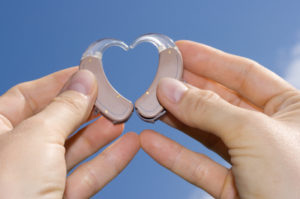 The hearing aids of today are light years ahead of the hearing aids made just a decade ago. I should know, because I’ve been wearing hearing aids for almost 18 years now. In fact, the changes in size, shape, and technological advances have been nothing short of amazing. For example, new micro-processor technology has allowed hearing aids to be so tiny, they can sit on a fingertip; and at the same time, provide amazingly natural-sounding hearing. So, people who need a little help hearing can get it “invisibly” and comfortably.
The hearing aids of today are light years ahead of the hearing aids made just a decade ago. I should know, because I’ve been wearing hearing aids for almost 18 years now. In fact, the changes in size, shape, and technological advances have been nothing short of amazing. For example, new micro-processor technology has allowed hearing aids to be so tiny, they can sit on a fingertip; and at the same time, provide amazingly natural-sounding hearing. So, people who need a little help hearing can get it “invisibly” and comfortably.
A major advancement in the latest hearing aids is the use of wireless technology. Hearing aids are not just jumping on the wireless arena; they’re actually blazing a new trail. As most people know, wireless communication is the technology that lets people connect with the Internet from their computers and tablets, without wires. Wireless headphones let individuals listen to music being streamed from a computer, iPod® or MP3 player, wire-free. Wireless printers let you print from a computer without a physical connection, and wireless car starters can start a car from many feet away, with the touch of a button.
This same wireless technology is used in today’s most advanced hearing aids to give hearing aid wearers many exciting new innovations.
For example, hearing aid wearers now have the freedom to adjust their hearing aids using their iPhone® or Android™ phone as a discreet remote control. Some new capabilities lets an individual use their phone to adjust the hearing aid volume in one or both ears, change listening settings to match their current environment, reduce background noise during a phone conversation, and much more. A person can make these adjustments with the swipe of a finger – with no one the wiser.
There is also wireless technology to give hearing aid users a superb phone call experience on their iPhone® or Android™ device. With this new technology, a hearing aid wearer hears the phone ring in their hearing aids, even if the phone is stowed away in a pocket, purse or briefcase. They simply press a button on a special device worn on a shirt, lapel or inside a shirt pocket, to start the conversation.
Because the sound digitally streams from the phone directly into the hearing aids, it’s exceptionally clear and clean. Also, because sound enters devices that have been carefully programmed for a person’s specific hearing needs, the listening experience is tailored just for them. And, people can listen to the conversation in both ears, instead of just one, if they prefer. Additionally, phone conversations can be hands-free. People with hearing loss can stay legal in places that ban holding a phone while driving. It’s also easier to multi-task during a phone call when both hands are free.
Through the use of wireless technology,hearing-aided people can now enjoy TV, stereo, PCs and other audio sources in a whole new way. When watching TV or listening to music, sound can stream from the source directly into the hearing aids. Volume can be adjusted to a comfortable level for the hearing-aided person, without affecting what others hear. And, because relay neck-loops aren’t needed, the individual can walk around the room and converse with companions – and still clearly hear the audio.
Another innovation made possible by wireless technology is a clever hearing aid accessory that helps users hear very precisely in environments such as lectures, meetings, noisy restaurants, or airports. A small, portable device is worn by someone the hearing-aided person wants to hear. The device picks up the non-hearing-aided person’s voice and streams it into the hearing aid wearer’s instruments, in real time. This device can also be placed in front of a television at a friend’s house, for example. It then streams sound directly into a person’s hearing aids, so they can hear clearly at whatever volume is comfortable for others.
Hearing aids have never been smaller, or better at providing a natural listening experience. And, upgrades in hearing aid technology will continue to evolve, allowing people with hearing loss the flexibility to find a solution that works for their lives, and lets them hear with confidence.
iPhone is a trademark of Apple Inc., registered in the U.S. and other countries. Android is a trademark of Google Inc.
